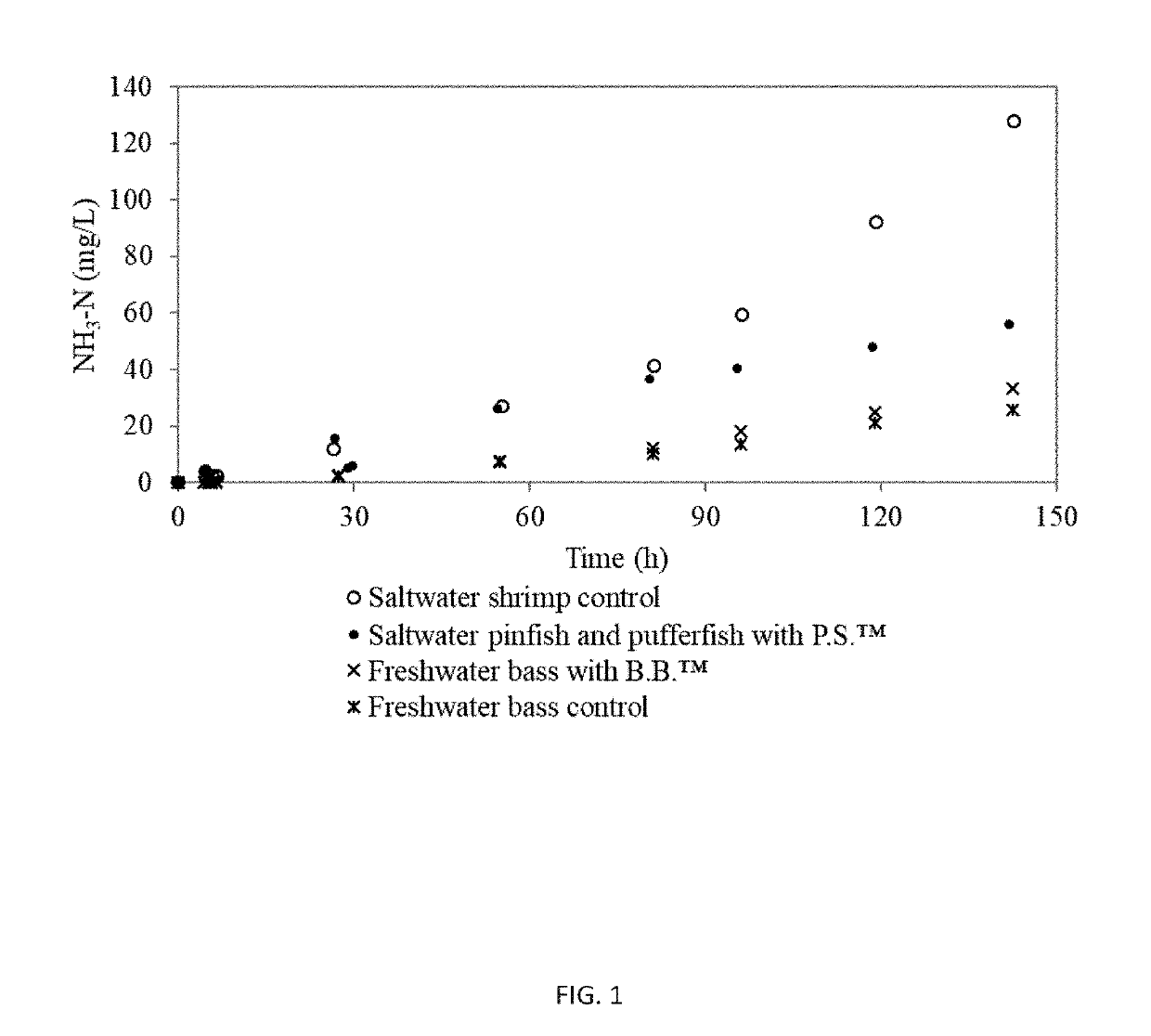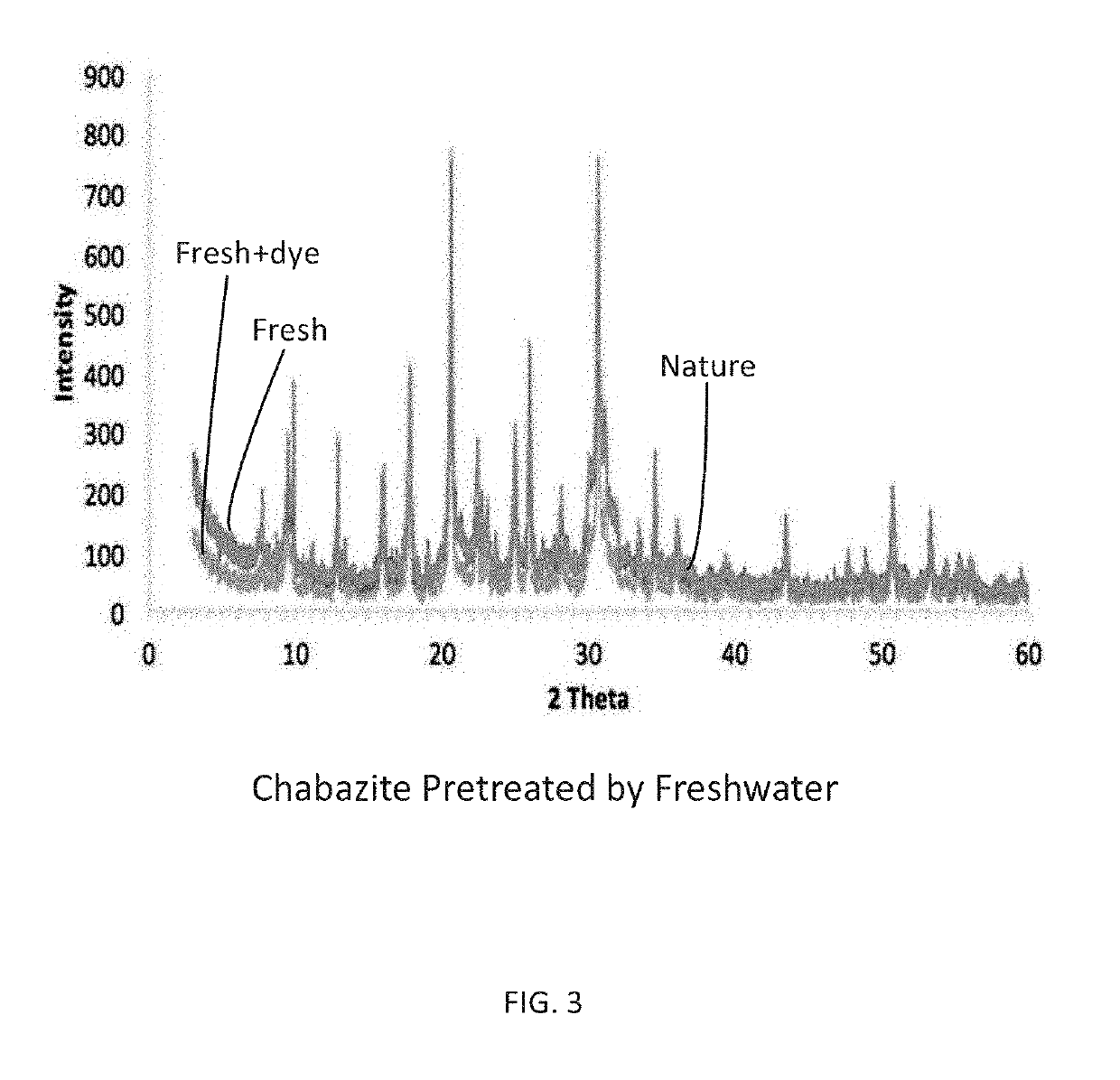Ammonia removal in freshwater and saltwater systems
a freshwater and saltwater technology, applied in the direction of silicates, other chemical processes, separation processes, etc., can solve the problems of increasing the ammonia concentration in the water, poisoning fish, and contaminating the closed system, and achieve the effect of high ammonium absorption capacity
- Summary
- Abstract
- Description
- Claims
- Application Information
AI Technical Summary
Benefits of technology
Problems solved by technology
Method used
Image
Examples
example 1
Test of Ammonia Removal
[0072]Two fish aeration systems were filled with 10 L of synthetic water. Each system included a 13 L container and an air pump. The NH4Cl solution was pumped into each system at a specified rate calculated from the aforementioned experiment. This design was used to simulate the condition as fish exit in the system. The ammonia removal agent (freshwater chabazite) was added into one aeration system. The other one was set up as a control group. Samples were taken every hour for 24 hours.
[0073]Ammonia concentrations of water samples were tested by high performance ammonia ion selective electrode (Fisher Scientific, Pittsburgh, Pa.). The ammonia removal efficiency (%) is calculated based on the final ammonia concentration in the control group (Ccontrol) and the experiment group (Cexperiment) by Equation 14:
ccontrol-cexperimentccontrol×100(14)
[0074]Previous trials of in-vitro experiments have found that no ammonia removal was observed when only phosphate buffer wa...
example 2
est of Ammonia Removal
[0086]Product preparation steps for freshwater and saltwater chabazite are summarized below:[0087]Freshwater Chabazite[0088]1. Chabazite (30 g) pretreated by synthetic freshwater at for 24 hrs (200 mL synthetic freshwater and 1 mL 5 g / L blue dye solution).[0089]2. Wash by DI water and dry in the oven at between 100° C. to 110° C. for 5 hours (110° C. preferred).[0090]3. Pack in a porous bag (30 g per bag) with a solid phosphate buffer, e.g. 0.8 Na2HPO4 and 0.3 g NaH2PO4 as solids.[0091]Saltwater Chabazite[0092]1. Chabazite (30 g) pretreated by 2M NaCl for 24 hrs (200 mL 2M NaCl and 1 mL 5 g / L blue dye solution).[0093]2. Wash by DI water and dry in the oven at between 100° C. to 110° C. for 5 hours (110° C. preferred).[0094]3. Pack in a porous bag (30 g per bag) with a solid phosphate buffer, e.g. 0.8 Na2HPO4 and 0.3 g NaH2PO4 as solids.
[0095]In-vivo tests were performed using live fish in an experimental container with the prepared chabazite and live fish in a ...
example 3
Experiment
[0102]Daphnia magna neonates (age50 of each chemical was also tested. The LC50 refers to the concentration of a substance that is lethal to 50% of the animals in the toxicity test (Boyd, 2005). The exposure periods were 24 and 48 hours. Five concentrations were tested from 0 to 2 g / L.
TABLE 11Daily maximum dose of ammonia removal substanceSubstancesDaily maximum dose (g / L / day)Freshwater4.6Chabazite (FC)Saltwater Chabazite8.8(SC)
[0103]The Daphnia Magna is the regulated specie by USEPA Toxic Substance Control Act (FSCA) for toxicity tests (Hayes, 2007). According to the EPA guideline for the toxicity test, the survival percentage of Daphnia Magna in the control group should be equal or higher to 90% at the end of testing time (USEPA, 2002). This criterion is fulfilled in this experiment. Both the freshwater chabazite and the saltwater chabazite was found to be nontoxic to Daphnia Magna neonates as shown in FIG. 11.
PUM
| Property | Measurement | Unit |
|---|---|---|
| pH | aaaaa | aaaaa |
| grain size | aaaaa | aaaaa |
| temperature | aaaaa | aaaaa |
Abstract
Description
Claims
Application Information
 Login to View More
Login to View More - R&D
- Intellectual Property
- Life Sciences
- Materials
- Tech Scout
- Unparalleled Data Quality
- Higher Quality Content
- 60% Fewer Hallucinations
Browse by: Latest US Patents, China's latest patents, Technical Efficacy Thesaurus, Application Domain, Technology Topic, Popular Technical Reports.
© 2025 PatSnap. All rights reserved.Legal|Privacy policy|Modern Slavery Act Transparency Statement|Sitemap|About US| Contact US: help@patsnap.com



